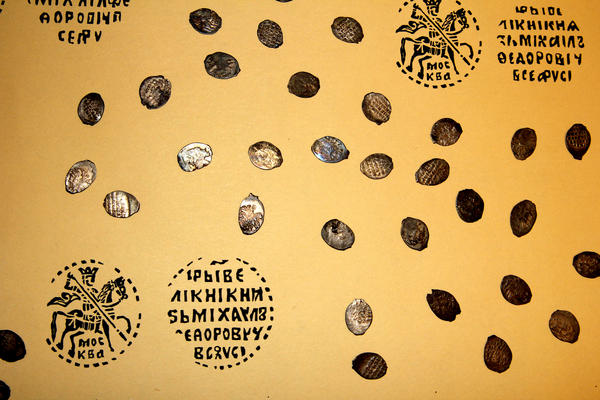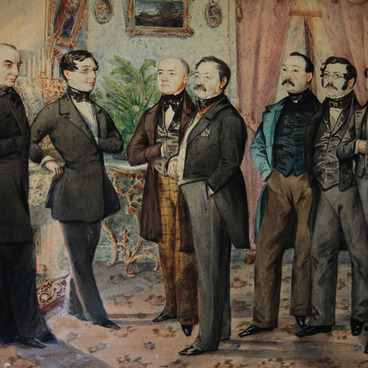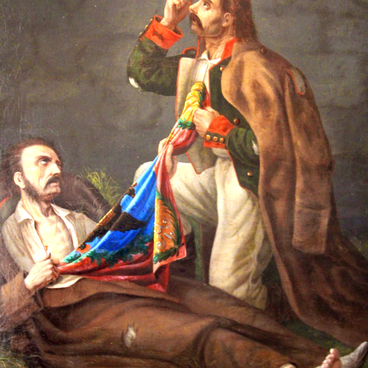The ancient treasure of the XVI–XVII centuries was discovered in Kaluga in May 2015. The clay thrift box that contained 365 Russian silver coins was found on Monastyrskaya street during earthworks.
The street is located on a high and according to the construction book (the book on urban construction and restoration) of the Kaluga suburb of the late XVI century, was called Triyaets hill in ancient times. It had 71 houses inhabited mostly by craftsmen and merchants: shoe makers, bakers, carpenters, tailors.
The treasure consisted primarily of kopecks. The larger part was coined in Moscow during the rule of Mikhail Fedorovich (1613 – 1645) – the first tsar of the Romanov dynasty. The coinage of such kopecks started after the change of the monetary unit. The unit meant the exact number of coins of the same denomination that could be coined from a certain weight of metal. In 1618 the monetary unit changed from 4 to 4.1 rubles from a pound (400 grams).
Some of the coins were coined in Pskov and Yaroslavl in 1617 and were not yet widely used in the early XVII century. The treasure also contained one kopeck from Novgorod. Scientists believe that the coins were hidden by one not wealthy resident of Triyaets hill around 1618.
Early XVII century was a difficult time for Kaluga. In 1611 the city fell under the rule of Polish invaders for a year and for several more years was in the center of hostilities. In 1615-1616 the fortress was attacked by Crimean Tartars, one more year later it was besieged by the troops of the Polish king’s son Vladislav IV, and in October 1618 it was captured by the Ukrainian hetman Petr Konashevich Sagaidachny. A traitor helped him get into the city, and the enemy army burnt the prison, demolished churches and plundered houses and shops. While in autumn 1618 the Kaluga settlement outside the fortress counted 383 houses, by December 1, when Sagaidachny left the city following Deulin peace, their number went down to 264. In general, over the troubled ten years the number of residential buildings in Kaluga halved.
The events apparently made the coin owner hide them from invaders. Most probably, he could not return to get his treasure because he was killed or taken prisoner.
The street is located on a high and according to the construction book (the book on urban construction and restoration) of the Kaluga suburb of the late XVI century, was called Triyaets hill in ancient times. It had 71 houses inhabited mostly by craftsmen and merchants: shoe makers, bakers, carpenters, tailors.
The treasure consisted primarily of kopecks. The larger part was coined in Moscow during the rule of Mikhail Fedorovich (1613 – 1645) – the first tsar of the Romanov dynasty. The coinage of such kopecks started after the change of the monetary unit. The unit meant the exact number of coins of the same denomination that could be coined from a certain weight of metal. In 1618 the monetary unit changed from 4 to 4.1 rubles from a pound (400 grams).
Some of the coins were coined in Pskov and Yaroslavl in 1617 and were not yet widely used in the early XVII century. The treasure also contained one kopeck from Novgorod. Scientists believe that the coins were hidden by one not wealthy resident of Triyaets hill around 1618.
Early XVII century was a difficult time for Kaluga. In 1611 the city fell under the rule of Polish invaders for a year and for several more years was in the center of hostilities. In 1615-1616 the fortress was attacked by Crimean Tartars, one more year later it was besieged by the troops of the Polish king’s son Vladislav IV, and in October 1618 it was captured by the Ukrainian hetman Petr Konashevich Sagaidachny. A traitor helped him get into the city, and the enemy army burnt the prison, demolished churches and plundered houses and shops. While in autumn 1618 the Kaluga settlement outside the fortress counted 383 houses, by December 1, when Sagaidachny left the city following Deulin peace, their number went down to 264. In general, over the troubled ten years the number of residential buildings in Kaluga halved.
The events apparently made the coin owner hide them from invaders. Most probably, he could not return to get his treasure because he was killed or taken prisoner.



